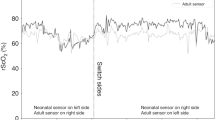Summary
Background. Oxygen tension sensors have been used to monitor tissue oxygenation in human brain for several years. The working principals of the most frequently used sensors, the Licox (LX) and Neurotrend (NT), are different, and they have never been validated independently for correct measurement in vitro. Therefore, we tried to clarify if the two currently available sensors provide sufficient accuracy and stability.
Method. 12 LX oxygen tension sensors and NT sensors were placed into a liquid-filled tonometer chamber. The solution was kept at 37 ± 0.2 °C and equilibrated with five calibration gases containing different O2- and CO2-concentrations. After equilibration, readings were taken for each gas concentration (accuracy test). Afterwards, the sensors were left in 3% O2 and 9% CO2 and readings were taken after 24, 48, 72, 96 and 120 hours (drift test). Thereafter, a 90% response time test was performed transferring sensors from 1% to 5% oxygen concentration and back, using pre-equilibrated tonometers.
Findings. All Licox oxygen probes [12] were used for this study. Two of 14 Neurotrend sensors did not calibrate, revealing a failure rate of 14% for NT. Oxygen tension during the accuracy test was measured as follows: 1% O2 (7.1 mmHg): LX 6.5 ± 0.4, NT 5.3 ± 2.3 mmHg, 2% O2 (14.2 mmHg): LX 12.9 ± 0.6, NT 12.1 ± 2.2 mmHg, 3% O2 (21.4 mmHg): LX 19.8 ± 0.7, NT 19.4 ± 2.4 mmHg, 5% O2 (35.8 mmHg): LX 33.4 ± 1.0 mmHg, NT 33.5 ± 2.9 mmHg, 8% O2 (57.0 mmHg): 53.8 ± 1.5, NT 53.6 ± 3.3 mmHg. After 120 hours in 3% O2 (21 mmHg), LX measured 19.8 ± 1.9 mmHg, NT 17.9 ± 4.7 mmHg. 90% response time from 1% to 5%/5% to 1% oxygen concentration was 129 ± 27/174 ± 26 sec for LX, 55 ± 19/98 ± 39 sec for NT.
Conclusions. Both systems are measuring oxygen tension sufficiently, but more accurately with LX probes. NT sensors read significantly lower pO2 in 1% O2 and show an increasing deviation with higher oxygen concentrations which was due to two of twelve probes. A slight drift towards lower oxygen tension readings for both sensors but more pronounced for the NT does not impair long-term use. NT measures pCO2 and pH very accurately.
Similar content being viewed by others
Author information
Authors and Affiliations
Rights and permissions
About this article
Cite this article
Hoelper, B., Alessandri, B., Heimann, A. et al. Brain oxygen monitoring: in-vitro accuracy, long-term drift and response-time of Licox- and Neurotrend sensors. Acta Neurochir (Wien) 147, 767–774 (2005). https://doi.org/10.1007/s00701-005-0512-8
Received:
Accepted:
Published:
Issue Date:
DOI: https://doi.org/10.1007/s00701-005-0512-8




